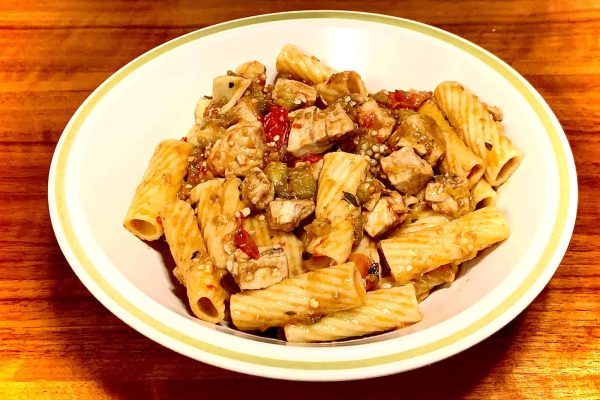We live just down the street from a little roadside stand that sells arguably some of the freshest seafood possible. We love to stop in and pick up whatever they happen to have and fashion a dish around that ingredient. This past weekend that dish happened to be Swordfish. I’ve never cooked it before, and I’ve only ever eaten it grilled as steaks. As we don’t currently own a grill, I had to come up with a different option.
One of my first stops for any recipe searches is one of my favorite sites, seriouseats.com. If you’ve never been, I highly recommend it become a staple. They have great how-to’s, all sorts of great bonus content and wonderful recipes, like this one. I did make a few minor changes, including doubling the recipe, halving the oil and adding one of my favorite flavor boosters in the form of capers.
Makes about 6-8 bowls
Takes about 30 minutes
Ingredients:
Kosher salt
1/4 cup extra-virgin olive oil, plus more as needed
2 eggplants peeled or unpeeled, cut into 1/2-inch dice, salted, drained and rinsed
3 medium clove garlic, sliced thin
1 heaping tbsp capers
2 pound swordfish, skin removed, flesh cut into 1/2-inch pieces
1 pound rigatoni or spaghetti
2 trays ripe cherry or other small tomatoes, cut in half
1/2 cup dry white wine
2 tsp oregano leaves chopped
Directions:
1. Fill a small pot with salted water and bring to a boil.
2. In a large skillet, heat olive oil over medium-high heat until shimmering. Add sliced garlic and keep moving until lightly browned. Remove from pan. Add eggplant to the oil and cook, stirring, until tender. Remove from pan and set aside with garlic, add oregano & capers.
3. Meanwhile, add pasta to boiling water and cook until al dente, according to manufacturer’s recommended timing. Reserve 2 cups of cooking water and drain the pasta.
4. Add tomatoes and white wine to skillet and cook until tomato and wine has reduced to a thick sauce.
5. Increase heat to medium-high and add swordfish and cook till Swordfish has cooked and sauce has thickened.
6. Return cooked eggplant to skillet. When pasta is cooked, transfer to skillet as well. Mix well and add pasta water until a smooth sauce has formed. Add a little more water than you think you’ll want as the pasta will continue to soak up the water.
7. Transfer to bowls and serve.

